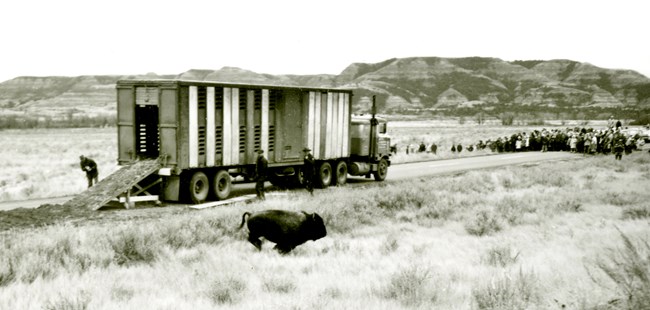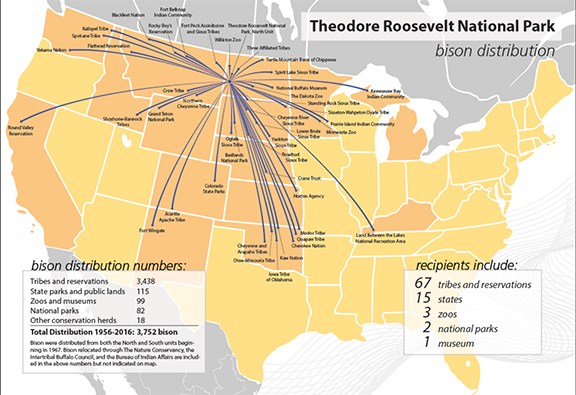
Bison are one of this country’s great symbols for wildlife and land conservation. Once numbering in the tens of millions, they were nearly driven extinct by the end of the 19th century due to rampant overhunting. Had it not been for the concern of early conservationists and ranchers, including Theodore Roosevelt, they may have been lost forever. Today, due to protection and reintroduction efforts, their numbers have rebounded from just a few hundred to around 30,000 in conservation herds (around 500,000 others exist on commercial ranches). There were no bison in the park when it was founded in 1947. They arrived nine years later, when 24 females and 5 males were brought to the South Unit from Fort Niobrara National Wildlife Refuge in Nebraska. Among those 29 founders were descendants of bison captured in the 1880s from Texas to Yellowstone to Saskatchewan Province. Six years later, 20 bison from the South Unit were relocated to found the North Unit herd. Bison are well adapted to deal with the harsh North Dakota climate and have thrived inside park boundaries. However, like the bison, wolves and grizzly bears were driven locally extinct during the 1800s—unlike the bison, they were never reintroduced. Without natural predators, bison populations increase over time, straining the park’s limited grazing resources. Based on the needs of bison and available resources, park biologists have set target herd sizes: 200-500 bison in the South Unit, and 100-300 in the smaller North Unit. To maintain a balanced ecosystem without natural predators, humans must take an active role in managing bison populations. 
NPS / Hazel Galloway Bison RoundupsHow is herd size managed? Every 2-3 years in both the South Unit and North Unit, the park conducts a bison roundup. The entire park staff works together at roundups, each team member assigned to a specific task. Handlers adhere to low-stress wildlife handling techniques, remaining quiet and using the minimum possible stimuli to move bison through the facility. This approach benefits both the bison and the handlers: not only are calm animals safer and easier to handle, but they are less likely to hurt one another. Roundups take place in October, after the conclusion of their breeding season. A helicopter is used to herd bison toward the wildlife handling facility, where they are funneled from large corrals into progressively smaller enclosures. Finally, they enter a mechanical “squeeze chute,” where a single bison can be safely examined by biologists and veterinarians. Park staff collect a blood sample from each bison to test for diseases such as brucellosis. They also collect a hair sample to extract DNA for genetic research. After each bison is weighed, measured, and its age determined, that information is added to the bison’s record. Finally, bison born since the previous roundup receive small metal ear tags and unique microchips, similar to those used in dogs and cats. This allows park biologists to track individual bison over many years. Predetermined goals for age classes and sex ratios in the herd help determine which bison will be released back into the park and which will be removed, known as “culling.” Bison selected for culling are loaded into trucks to be transported to their new homes. Current park policy allows culled bison to be exported to Native American tribes, as well as other agencies including zoos, state parks, and national parks. Between 1962 and 2016, the park shipped out 3,752 bison.
|
Last updated: September 28, 2023
